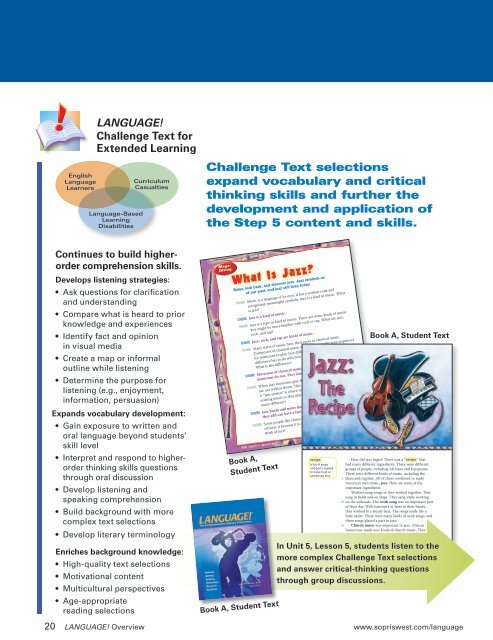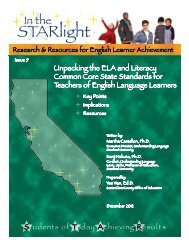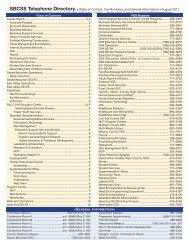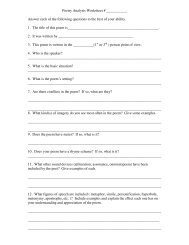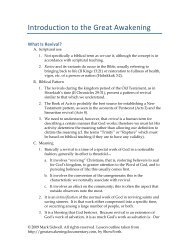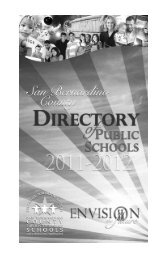4th Edition LANGUAGE! Overview
4th Edition LANGUAGE! Overview
4th Edition LANGUAGE! Overview
Create successful ePaper yourself
Turn your PDF publications into a flip-book with our unique Google optimized e-Paper software.
EnglishLanguageLearners<strong>LANGUAGE</strong>!Challenge Text forExtended LearningLanguage-BasedLearningDisabilitiesCurriculumCasualtiesChallenge Text selectionsexpand vocabulary and criticalthinking skills and further thedevelopment and application ofthe Step 5 content and skills.Continues to build higherordercomprehension skills.Develops listening strategies:• Ask questions for clarificationand understanding• Compare what is heard to priorknowledge and experiences• Identify fact and opinionin visual media• Create a map or informaloutline while listening• Determine the purpose forlistening (e.g., enjoyment,information, persuasion)Expands vocabulary development:• Gain exposure to written andoral language beyond students’skill level• Interpret and respond to higherorderthinking skills questionsthrough oral discussion• Develop listening andspeaking comprehension• Build background with morecomplex text selections• Develop literary terminologyEnriches background knowledge:• High-quality text selections• Motivational content• Multicultural perspectives• Age-appropriatereading selectionsMega-DialogWhat Is Jazz?Relax, kick back, and discover jazz. Jazz reminds usof our past, and jazz still lives today.TEACHER: Music is a language of its own. It has a written code andrecognized, meaningful symbols. Jazz is a kind of music. Whatis jazz?STUDENT: Jazz is a kind of music.TEACHER: Jazz is a type or kind of music. There are many kinds of music.You might be more familiar with rock or rap. What are jazz,rock, and rap?STUDENT: Jazz, rock, and rap are kinds of music.TEACHER: Many styles of music have their roots in classical music.Composers of classical music wrote very specific note sequencesfor musicians to play. Jazz differs from classical music. Thedifference has to do with how the musician uses written music.What is the difference?STUDENT: Musicians of classical music stick to the music. Jazzmusicians do not. They jam.TEACHER: When jazz musicians play their songs, they often add notes that114 Unit 5 • Jazz It Upare not written down. This is called improvising or “jamming.”A “jam session” is where musicians create new music or add toexisting music as they play. How do jazz musicians make theirmusic different?STUDENT: Jazz bands add notes that are not in the music. The notesthey add can have a fantastic impact!TEACHER: Some people like classical music for its style. Some peopleBook A,Student TextBook A, Student Textcriticize it because it is rigid. What do critics of classical musicthink of jazz?recipea list of stepsand parts neededto make food orsomething else118 Unit 5 • Jazz It UpBook A, Student TextHow did jazz begin? There was a “ recipe ” thathad many different ingredients. There were differentgroups of people, including Africans and Europeans.There were different kinds of music, including the5 blues and ragtime. All of these combined to makeAmerica’s own music, jazz. Here are some of theimportant ingredients.Workers sang songs as they worked together. Theysang in fields and on ships. They sang while working10 on the railroads. The work song was an important partof their day. With hammers or hoes in their hands,they worked to a steady beat. The songs made life alittle easier. There were many kinds of work songs, andthese songs played a part in jazz.15 Church music was important to jazz. AfricanAmericans made new kinds of church music. TheyIn Unit 5, Lesson 5, students listen to themore complex Challenge Text selectionsand answer critical-thinking questionsthrough group discussions.BookA20 <strong>LANGUAGE</strong>! <strong>Overview</strong> www.sopriswest.com/language


